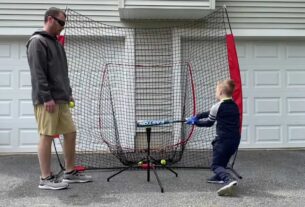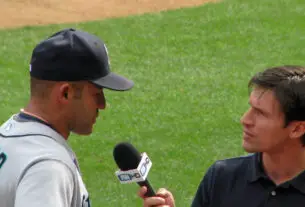Basic baseball fielding drills for 8-year-olds include ground ball practice and catching pop flies. Focus on fundamental skills and fun activities.
It takes patience and engaging drills to teach fielding to 8-year-olds. Children can start with simple exercises such as ground ball practice. Improve hand-eye coordination by catching pop flies. To keep them interested, incorporate fun elements like relay races.
Their skills and confidence grow with consistent practice. Teamwork and positive reinforcement foster a love of the game. Drills that are varied and enjoyable keep young players enthusiastic and committed to improving their fielding skills.
Importance Of Fielding Drills
Boosting 8-year-olds’ confidence on the field with baseball fielding drills is crucial. The drills teach young players how to catch, throw, and move efficiently. This ensures that kids develop the necessary abilities early in their baseball journey.
Building Fundamental Skills
Fielding drills play a crucial role in building fundamental skills in young baseball players. At this age, kids are eager to learn and improve. Drills help them understand the basics of fielding and make them more effective on the field.
Some essential skills that fielding drills develop include:
- Proper Stance: Kids learn to stand correctly, which helps them react quickly.
- Glove Positioning: Drills teach the correct way to hold and use the glove.
- Footwork: Good footwork is crucial for moving to the ball effectively.
Consider using a table to outline specific drills and their benefits:
| Drill | Benefit |
| Ground Ball Drill | Improves glove work and footwork |
| Fly Ball Drill | Enhances catching skills |
| Throwing Drill | Boosts accuracy and strength |
By practicing these drills, kids build a strong foundation that helps them succeed in more advanced techniques. Consistency is key; regular practice makes these skills second nature.
Developing Hand-eye Coordination
Another significant benefit of fielding drills is developing hand-eye coordination. This skill is vital for young baseball players as it helps them track and catch the ball effectively.
Some effective drills for improving hand-eye coordination include:
- Wall Ball Drill: Players throw a ball against a wall and catch it on the rebound. This drill sharpens reaction time and catching ability.
- Partner Toss Drill: Pairing up with another player to toss and catch the ball improves timing and coordination.
- Soft Hands Drill: Using softer balls or foam balls teaches kids to catch with soft hands, enhancing their control and precision.
Engaging and fun drills make practice enjoyable for kids. Children can develop hand-eye coordination by incorporating these activities. Taking part in these drills regularly helps young players develop their baseball skills.

Drills For Ground Balls
Baseball fielding drills help young players develop their skills. 8-year-olds need ground ball drills. It builds confidence and improves reaction times. Advanced fielding techniques begin with teaching kids how to handle ground balls. Two drills are discussed here: the Stationary Ground Ball Drill and the Moving Ground Ball Drill.
Stationary Ground Ball Drill
A Stationary Ground Ball Drill is perfect for beginners. It teaches kids how to field ground balls without overwhelming them. Start by having the players stand in a ready position. With knees bent, glove on ground, and eyes on ball, this position is effective.
Follow these steps for the drill:
- Set up: Place the players in a line, each with a ball.
- Coach’s Role: Roll the ball gently towards each player.
- Player’s Task: Field the ball cleanly and throw it back.
Repeat this process several times, ensuring each player gets multiple turns. Emphasize the importance of keeping the glove low and watching the ball into the glove. This drill builds muscle memory and teaches proper hand-eye coordination.
Here’s a simple table for a quick reference:
| Step | Description |
| 1 | Players in ready position |
| 2 | Coach rolls ball gently |
| 3 | Player fields ball and throws back |
Encourage the players to communicate with each other. Saying “I’ve got it” builds teamwork and confidence. This drill is simple yet effective for young players learning the basics of fielding.
Moving Ground Ball Drill
The Moving Ground Ball Drill adds a level of difficulty by incorporating movement. This drill helps players learn to field ground balls while moving, mimicking real game situations. Begin by having players in a ready position, similar to the stationary drill.
Follow these steps:
- Set up: Players line up, with the coach or another player rolling the ball.
- Movement: Players move laterally to field the ball.
- Fielding: Players scoop the ball and make a throw to a target.
This drill can be modified to increase difficulty. Vary the speed and direction of the ball. Encourage players to stay low and keep their glove in front.
For a more engaging experience, turn it into a mini-competition. Set up cones to create lanes and see who can field the most ground balls cleanly. This keeps the drill fun and motivates kids to improve.
Here’s a quick reference table:
| Step | Description |
| 1 | Players in ready position |
| 2 | Coach rolls ball with varying speed/direction |
| 3 | Players move laterally to field ball |
| 4 | Players throw to a target |
Incorporating movement in drills prepares players for real-game scenarios. This drill enhances their agility and quick decision-making skills.
Drills For Fly Balls
Baseball fielding drills help young players improve their skills. Fly balls can be tricky for 8-year-olds. Practicing these drills builds confidence and skill. Let’s explore some effective drills for catching fly balls.
Bucket Drill
The Bucket Drill is a fun way to practice catching fly balls. It helps kids learn to judge the distance and speed of the ball. Here’s how to set it up:
- Gather a bucket of baseballs and a glove for each player.
- Coach or parent stands about 10-20 feet away from the player.
- Toss the ball high into the air for the player to catch.
- Encourage players to call out “Mine!” to avoid collisions.
- After catching, the player drops the ball in the bucket and gets ready for the next one.
Repeat the drill 10-15 times for each player. This helps them get comfortable catching balls from different angles. It also improves hand-eye coordination.
Key tips:
- Keep eyes on the ball.
- Use two hands to secure the catch.
- Stay relaxed and focused.
With regular practice, the Bucket Drill boosts catching confidence and skill.
Outfield Relay Drill
The Outfield Relay Drill teaches teamwork and quick throws. It’s excellent for improving relay throws to the infield. Here’s how to do it:
- Divide players into two teams.
- Each team forms a line from the outfield to the infield.
- The first player in line catches a fly ball and quickly throws it to the next player.
- The ball is relayed through each player until it reaches the infield.
- The last player throws the ball to the catcher at home plate.
This drill fosters communication and quick decision-making. It teaches players to relay the ball efficiently.
Important aspects:
- Proper throwing technique.
- Quick and accurate throws.
- Good communication among players.
Run the drill several times, switching up positions. This ensures every player gets a chance to practice different roles.
With consistent practice, the Outfield Relay Drill sharpens fielding skills and teamwork.

Drills For Throwing Accuracy
Baseball is a fun game for kids, and they can start playing early. Practicing fielding drills helps 8-year-olds improve their skills. Throwing accuracy drills are essential for young players. These drills help them aim the ball correctly. These drills can help kids become better throwers.
Target Practice Drill
The Target Practice Drill is a simple yet effective way to improve throwing accuracy. Kids enjoy this because it’s like a game. You’ll need a target, which can be anything from a hula hoop to a chalk-drawn circle on a wall. Here’s how to set it up:
- Place the target about 10 feet away from the kids.
- Give each child a ball.
- Have them take turns throwing the ball at the target.
Important points to remember:
- Encourage kids to focus on the target.
- Remind them to use the proper throwing technique.
- Make sure they step forward with their opposite foot.
Benefits of the Target Practice Drill:
| Benefit | Description |
| Improves focus | Kids learn to concentrate on a single point. |
| Enhances technique | Proper form gets reinforced with every throw. |
| Boosts confidence | Kids feel good when they hit the target. |
Make this drill more fun by setting up a points system. Award points for hitting the target and keep a scoreboard. This will motivate kids to try harder and improve their accuracy.
Cone Toss Drill
The Cone Toss Drill is another excellent way to enhance throwing accuracy. It involves using cones and is great for team practice. Here’s how to set it up:
- Place several cones in a straight line, about 5 feet apart.
- Each cone should be a different color, if possible.
- Kids stand about 10 feet away from the first cone.
Steps to follow:
- Have each child throw a ball to knock over the cones.
- Start with the closest cone and move to the farthest.
- Encourage them to aim carefully and use proper technique.
Benefits of the Cone Toss Drill:
- Improves distance control: Kids learn to adjust their throws based on the distance.
- Enhances aim: Aiming at smaller targets improves precision.
- Builds teamwork: Doing this in a group encourages kids to cheer for each other.
Pro Tips:
- Rotate the order of the cones to keep the drill challenging.
- Introduce a timer to add a fun, competitive element.
- Use lightweight balls to reduce the risk of injury.
Both the Target Practice Drill and the Cone Toss Drill are fun and effective ways to help 8-year-olds improve their throwing accuracy. These drills not only make them better players but also boost their confidence and love for the game.
Drills For Quick Reaction
For 8-year-olds, baseball fielding drills are essential for developing their skills. Playing quick reaction drills helps young players react quickly during games. This drill improves hand-eye coordination, agility, and focus. The following drills will help young baseball players improve their quick reactions.
Reaction Ball Drill
The Reaction Ball Drill is a fun and effective way to improve quick reactions. The drill uses an irregularly shaped ball that bounces unpredictably, making it perfect for sharpening reflexes.
- Equipment: Reaction ball
- Setup: Find a flat surface, like a gym floor or a driveway
Steps:
- Stand about 10 feet away from a wall.
- Throw the reaction ball against the wall.
- Try to catch the ball as it bounces back.
Repeat this process, aiming to catch the ball as quickly as possible. This drill helps improve hand-eye coordination and teaches kids to stay alert. Make it more fun by timing the catches or setting up friendly competitions.
Reaction Glove Drill
The Reaction Glove Drill focuses on improving the speed and accuracy of glove work. This drill is straightforward but highly effective in enhancing a young player’s fielding skills.
- Equipment: Baseball glove, tennis ball
- Setup: A partner to throw the ball
Steps:
- Stand about 15 feet away from your partner.
- Your partner throws the tennis ball at different speeds and angles.
- Use your glove to catch the ball as quickly as possible.
To add variety, ask your partner to mix up the throws. They can toss high, low, fast, or slow. This keeps the young player on their toes and helps improve their ability to react swiftly.
Repeat the drill, increasing the difficulty level as skills improve. This drill builds both confidence and competence in young fielders.

Drills For Communication
A baseball fielding drill is crucial for 8-year-olds’ development. The most important skill they need is communication. Communicating well helps players understand their roles. By doing so, teamwork improves. Young players need drills for communication to ensure they know when and what to do.
Cut-off Drill
The Cut-off Drill helps young players understand the importance of communication during a play. This drill focuses on the interaction between outfielders and infielders. Here’s how to conduct this drill:
- Set up the field with an outfielder, an infielder, a catcher, and a coach acting as the batter.
- The coach hits the ball to the outfield. The outfielder must quickly retrieve the ball and look for the infielder.
- The infielder positions themselves to receive the throw and calls out “Cut!” if they want the ball or “Home!” if the throw should go to the catcher.
- The outfielder must listen and throw the ball accordingly.
Key points to remember:
- Communication should be loud and clear.
- Outfielders should always look for the infielder’s signal.
- Infielders should be quick to decide and communicate.
| Role | Task |
| Outfielder | Retrieve ball, look for infielder |
| Infielder | Position and communicate |
| Catcher | Be ready to receive the throw |
| Coach | Act as batter |
Practicing this drill ensures players understand their roles and improves overall team coordination.
Infield Communication Drill
The Infield Communication Drill teaches infielders to communicate effectively during plays. This drill focuses on making sure everyone knows their responsibilities and can execute plays quickly. Here’s how to run this drill:
- Set up the infield with players at each base and a coach as the batter.
- The coach hits ground balls to different infielders.
- Infielders must field the ball and call out their play (e.g., “First!” or “Second!”).
- Other infielders must listen and prepare for the throw.
Important aspects to focus on:
- Clear and loud communication.
- Quick decision making.
- Players should always be aware of the game situation.
| Position | Task |
| First Baseman | Catch throws to first base |
| Second Baseman | Field ground balls, throw to first or second |
| Shortstop | Field ground balls, throw to second or first |
| Third Baseman | Field ground balls, throw to first or second |
Practicing this drill regularly helps players to stay focused and make the right decisions quickly.
Drills For Footwork
Baseball fielding drills are essential for young players. For 8-year-olds, focusing on footwork is crucial. Good footwork helps kids move swiftly and accurately on the field. This ensures they can make plays with confidence. Here are some effective drills for footwork that will help young players excel.
Ladder Drill
The Ladder Drill is fantastic for improving agility and quickness. It involves a series of steps that kids follow on a ladder laid flat on the ground. This drill helps in developing coordination and speed. Here’s how to do it:
- Lay the ladder flat on the ground.
- Have the child start at one end of the ladder.
- They should step into each square of the ladder with both feet, one after the other.
- Encourage them to move quickly but maintain balance.
Repeat this drill for about 5 minutes. You can vary the drill by introducing different foot patterns:
- Two Feet In, Two Feet Out: Step in with both feet, then step out to the sides.
- Sideways Shuffle: Move sideways through the ladder, placing both feet in each square.
| Variation | Instructions |
| Two Feet In, Two Feet Out | Step in with both feet, step out to the sides, repeat. |
| Sideways Shuffle | Move sideways, placing both feet in each square. |
These variations keep the drill fun and challenging. They also help in building different aspects of footwork.
Cone Shuffle Drill
The Cone Shuffle Drill improves lateral movement and quick direction changes. It’s simple and effective for young players. Here’s how to set it up:
- Set up four cones in a square, about 5 feet apart.
- Have the child start at one cone.
- They should shuffle sideways to the next cone, touch it, and shuffle back.
Repeat this for about 5 minutes. To add variety, you can:
- Change Directions: Instruct them to shuffle in the opposite direction.
- Increase Speed: Encourage them to move faster with each round.
This drill enhances quick direction changes and lateral speed. It’s great for fielders who need to react quickly to the ball. Here’s a simple table to summarize the steps:
| Step | Instructions |
| 1 | Set up four cones in a square. |
| 2 | Start at one cone, shuffle sideways to the next cone. |
| 3 | Touch the cone and shuffle back. |
Using these drills regularly will help young players develop strong footwork. This will enhance their overall fielding skills.
Conclusion
Strong foundations are built by mastering fielding drills early. For 8-year-olds, these drills make practice fun. Practicing consistently builds confidence and skills. Let your child enjoy the game and grow in abilities.
Happy fielding!



